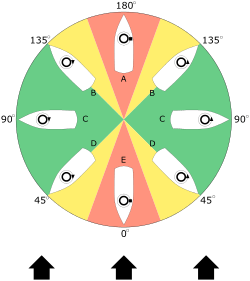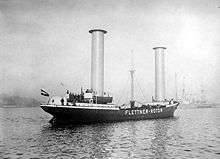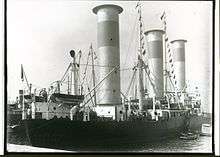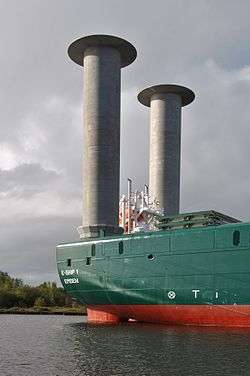Rotor ship
A rotor ship, or Flettner ship, is a type of ship designed to use the Magnus effect for propulsion. The Magnus effect is a force acting on a spinning body in a moving airstream, which acts perpendicularly to the direction of the airstream. In addition to the familiar principle of backspin imparted to increase range in ball sports, the Magnus effect was also employed in the bouncing bombs developed by Barnes Wallis.[1]
Rotor ships typically use rotor sails powered by a motor to take advantage of the effect. German engineer Anton Flettner was the first to build a ship which attempted to tap this force for propulsion.
Background

A rotor/Flettner ship is a type of ship designed to use the Magnus effect for propulsion.[2] The Magnus effect is a force acting on a spinning body in a moving airstream, which acts perpendicularly to the direction of the airstream. Rotor ships typically use rotor sails — spinning bodies that are essentially vertical cylinders — powered by a motor to take advantage of the effect. These types of propulsion cylinders are now commonly called Flettner rotors. Rotor ships have unique points of sail.
Original vessels
Invention


The German engineer Anton Flettner was the first to build a ship which attempted to use the Magnus effect for propulsion.[3][4][5]
Assisted by Albert Betz, Jakob Ackeret, and Ludwig Prandtl, Flettner constructed an experimental rotor vessel; October 1924 the Germaniawerft finished construction of a large two-rotor ship named Buckau.[6] The vessel was a refitted schooner which carried two cylinders (or rotors) approximately 15 metres (50 ft) high, and 3 metres (10 ft) in diameter, driven by an electric propulsion system of 50 hp (37 kW) power. In 1926, a larger ship with three rotors, the Barbara, was built by the shipyard A.G. Weser in Bremen.[7]
Voyages
Following completion of its trials, the Buckau set out on her first voyage, from Danzig to Scotland across the North Sea, in February 1925.[8] The rotor ship could tack (sail into the wind) at 20-30 degrees,[6] while a vessel with a typical sail rig, cannot tack closer than 45 degrees to the wind; hence, the rotors did not give cause for concern in stormy weather.
On 31 March 1926, the Buckau, now renamed Baden Baden after the German spa town, sailed to New York via South America, arriving in New York Harbor on 9 May.[9]
Despite having completed trouble free crossings of the North Sea and Atlantic the power consumed by spinning 15m tall drums was vastly disproportionate to the propulsive effect when compared with conventional screws (propellers). As the Flettner system could not compete economically Flettner turned his attention to other projects, such as his rotor aircraft.[10]
The rotors were removed[11] and the Baden Baden returned to screw power, until destroyed in a Caribbean storm in 1931.
Types
Several types of rotor ships can be distinguished. Rotor sail-only ships exist, as do rotor sail-assist (hybrid) ships. Wind Ship Development Corporation has two types of sail-assist designs, for use with different sizes of ships.[12] In practice, most rotor ships have a system with an electric motor that allows the initial start and eventual stop of the rotor by crew. Rotor's rotational speed (i.e., RPM) and direction of spin can also be controlled.
Uses today

There has been renewed interest in the rotor ship concept in the later 20th century, starting with Jacques-Yves Cousteau's Alcyone in 1983.[2]
The German wind-turbine manufacturer Enercon launched and christened a new rotor ship, E-Ship 1 — see opening image, this article — on 2 August 2008.[13] The ship is being used to transport turbines and other equipment to locations around the world;[13] the maiden delivery of turbines for Castledockrell Windfarm arrived in Dublin Port on 11th Aug 2010.[14] On 29 July 2013, Enercon provided a press release claiming a potential for "operational fuel savings of up to 25% compared to same-sized conventional freight vessels." after 170,000 sea miles; actual performance figures were not provided.[15]
The University of Flensburg is developing the Flensburg catamaran or Uni-Cat Flensburg, a rotor-driven catamaran.[16]
The THiiiNK Holding organization describes an improved version of the Flettner Rotor that is retractable and supplemented by an additional control surface.[17] The page claims that "The system has been developed and tested both in tank tests and in full-scale sea trials." The design improvement claims include improved rotor performance (by 50% or more), and an improved internal rate of return (IRR) compared to a standard rotor (up to 55%).[17]
In 2007, Stephen H. Salter and John Latham proposed the building of 1,500 robotic rotor ships to mitigate global warming. The ships would spray seawater into the air to enhance cloud reflectivity.[18][19] A prototype rotor ship was tested on Discovery Project Earth; The rotors were made of carbon fibre and were attached to a retrofitted trimaran and successfully propelled the vessel stably through the water at a speed of six knots. The focus of the experiment was based on the ability for the boat to move emissions free for a specialized purpose, leaving it unclear whether or not the efficiency of the rotors was on parity, inferior to, or superior to conventionally propelled vessels.
In 2009 the Finland-based maritime engineering company Wärtsilä unveiled a concept for a cruiseferry that would utilise Flettner rotors as means of reducing fuel consumption. This concept has been developed in association with the Finnish ferry operator Viking Line,[20] (the ship, M/S Viking Grace, was built 2011–2012, without the rotors).
In 2014 Norsepower, a Finnish clean technology and engineering company pioneering the generation of renewable wind energy for the global maritime industry, announced that it will bring to the market the "Norsepower Rotor Sail Solution"[21] which is a completely modernized version of the Flettner rotor. Later in 2014 Norsepower installed the first Norsepower Rotor Sail on Finnish shipping company Bore's RoRo vessel M/V Estraden, and in the end of 2015 Norsepower installed a second similar unit on the same ship. In the beginning of 2016 it was released by Norsepower, that based on the successful sea trials on board M/V Estraden, the technology has potential for fuel savings of up to 20% for vessels with multiple, large rotors traveling on favourable wind routes.[22]
After Norsepower's success with the new design, also Viking Line returned with the rotor concept for their next planned newbuilding. The first image of a new 63,000 GT vessel shows large flettner rotors which could help the ship to reduce fuel consumption with up to 15%. Letter of intent was signed for the ship in November 2016, awaiting final agreements signing in early 2017.[23] According to a Finnish newspaper, the rotor concept of Viking Line is based on Norsepower Rotor Sails.[24]
Further reading
- Anon. (2015). "Flettner rotor". Thiiink Holding. Retrieved 12 October 2015. [Includes text descriptions, and videos of the Magnus effect, the The Flettner principle, and of the Buckau Flettner Rotor Test 1925, the E-Ship 1 Flettner vessel, and the UNI-CAT Flettner vessel.]
- Gilmore, C.P. (1984). "Spin Sail: Harnesses Mysterious Magnus Effect for Ship Propulsion," Popular Science (January), pp. 70–73, Chicago, IL, USA: Bonnier Corporation, see accessed 13 October 2015.
- Greenslade, Jr., Thomas B. (1971). "A Forgotten Magnus Effect Demonstration," The Physics Teacher Vol. 9, 43-44, see [The Flettner Rotorship], accessed 13 October 2015.
- Bowen, Frank (1936). Winchester, Clarence, ed. "Rotor ships: Why the application of the rotor to ship propulsion, after having proved satisfactory, did not remain long upon the high seas". Shipping Wonders of the World. 1 (13): 398–399. Retrieved 12 October 2015. [illustrated description of rotor ships]
See also
References
- ↑ "The Bouncing Bomb". www.dambusters.org.uk. Retrieved 3 May 2016.
- 1 2 Hubert Chanson (30 August 2013). Applied Hydrodynamics: An Introduction. CRC Press. pp. 100–. ISBN 978-1-315-86304-7.
- ↑ Bonnier Corporation (September 1925). Popular Science. Bonnier Corporation. pp. 27–. ISSN 0161-7370.
- ↑ G. A. Tokaty (20 February 2013). A History and Philosophy of Fluid Mechanics. Courier Corporation. pp. 150–. ISBN 978-0-486-15265-3.
- ↑ Albert Einstein (27 September 2011). Essays in Science. Philosophical Library/Open Road. pp. 61–. ISBN 978-1-4532-0479-5.
- 1 2 Reed Business Information (10 March 1983). New Scientist. Reed Business Information. pp. 658–. ISSN 0262-4079.
- ↑ Fred M Walker (5 May 2010). Ships and Shipbuilders: Pioneers of Design and Construction. Seaforth Publishing. pp. 220–. ISBN 978-1-84832-072-7.
- ↑ G. A. Tokaty (1994). A History and Philosophy of Fluid Mechanics. Courier Corporation. pp. 152–. ISBN 978-0-486-68103-0.
- ↑ United States Naval Institute (1970). Proceedings.
- ↑ Ray, Keith. The Strangest Aircraft of All TIme. Stroud, Gloucester GL5 2QG: The History Press. p. 48. ISBN 9780750960977.
- ↑ "BAden-Baden discards old rotor air motors". St. Petersburg Times. October 26, 1928.
- ↑ Gilmore, C.P. (1984). "Spin Sail: Harnesses Mysterious Magnus Effect for Ship Propulsion," Popular Science (January), pp. 70-73, see , accessed 13 October 2015.
- 1 2 Bahman Zohuri (3 September 2016). Nuclear Energy for Hydrogen Generation through Intermediate Heat Exchangers: A Renewable Source of Energy. Springer. pp. 23–. ISBN 978-3-319-29838-2.
- ↑ Kennedy, John (2010). "Discovery: State-of-the-art cargo ship to dock with haul of wind turbines". Silicon Republic (online, August, 10). Retrieved 12 October 2015.
- ↑ Anon. (2012). "PM E-Ship1 Ergebnisse DBU" (PDF). Enercon.de. Archived from the original (PDF) on June 7, 2014. Retrieved 2015-10-12.
- ↑ Anon. (2015). "Flettner rotor". Thiiink Holding. Retrieved 12 October 2015.
- 1 2 Anon. (2015). "Folding Flettner Rotor Wing". Thiiink Holding. Retrieved 12 October 2015.
- ↑ Latham, John (2007). "Futuristic fleet of 'cloudseeders' (15 February)". BBC. Archived from the original on 2012-07-25. Retrieved 2012-07-25.
- ↑ Salter, Stephen; Sortino, Graham; Latham, John (2008). "Sea-going hardware for the cloud albedo method of reversing global warming". Phil. Trans. R. Soc. A. 366 (1882, 13 November): 3989–4006. Bibcode:2008RSPTA.366.3989S. doi:10.1098/rsta.2008.0136. PMID 18757273. Retrieved 2009-07-27.
- ↑ Reinikainen, Kari (2009). "Wind and lng [liquified natural gas] power Wartsila's cruise ferry design". Cruise Business Online (22 June). Retrieved 2010-01-19.
- ↑ Norsepower Rotor Sail Solution
- ↑ "Norsepower". www.norsepower.com. Retrieved 2016-11-25.
- ↑ "hbl". Retrieved 25 November 2016.
- ↑ "Viking Linen uuden laivan katolle tulee 24 metriä korkeat, "vähän hassunnäköiset" purjeet". Ilta-Sanomat (in Finnish). 2016-11-23. Retrieved 2016-11-25.
External links
| Wikimedia Commons has media related to Rotor ships. |
- Center for the Study of Technology article
- Photograph of Baden Baden in NY harbour
- Bore to trial Norsepower Rotor Sail on Ro-Ro

